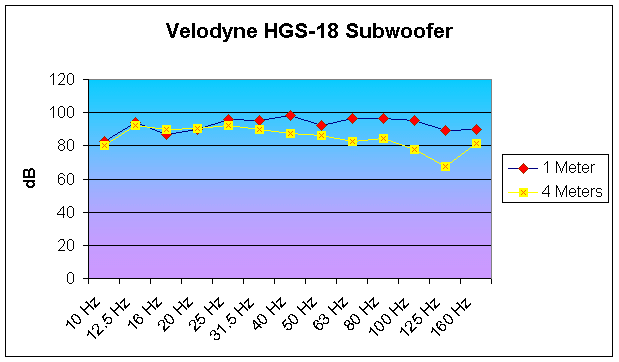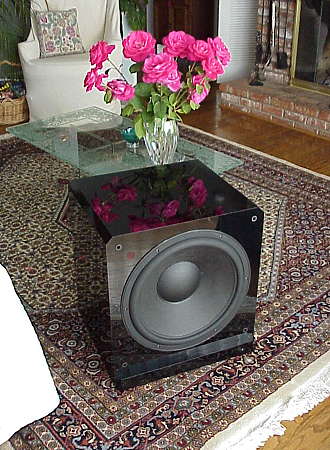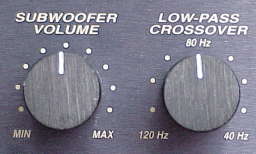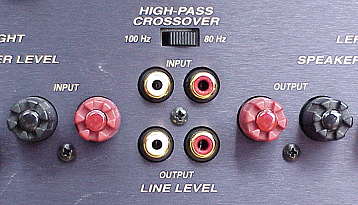Product Review - Velodyne HGS-18 Powered Subwoofer - December, 1999 John E. Johnson, Jr.
|
Velodyne HGS-18 Powered Subwoofer 18" Forward Firing Driver, 23 Pound Magnet 1,250 Watt rms Digital Switching Amplifier, Line-Level (RCA and XLR) and Speaker-Level Inputs and Outputs MFR: 15 Hz - 120 Hz � 3 dB High Pass: 80 Hz or 100 Hz, 6 dB per Octave Low Pass: 40 Hz - 120 Hz, 12 dB per Octave Phase Switch - 00 or 1800 Size: 23"H x 21"W x 20"D Weight: 105 Pounds MSRP: $2,999 USA |
| Velodyne Acoustics, Inc., 1070 Commercial Street, Suite 101, San Jose, California 95112; Phone 408- 436-7270; Fax 408-436-7276; E-Mail [email protected]; Web http://www.velodyne.com. |
Introduction
In terms of low frequency production, there is nothing . . . and I mean nothing, like a huge driver in a huge box with a huge amplifier. Those criteria are met by the Velodyne HGS-18, their latest entry into the world of high performance subwoofers. The HGS-18 is one of four models in the HGS series, with the others being the HGS-10, HGS-12, and HGS-15, the numbers being their driver size. They all have the same digital switching amplifier, capable of delivering 1,250 watts rms. On average, the user would not encounter the need for that many watts, but more likely, it would be using just a few hundred (!!)
As you can see from the photo above, the HGS-18 has a gloss black piano finish veneer. (The roses are courtesy of my wife's garden.) Even though the enclosure is necessarily large, the reflections of surrounding items almost make it disappear into the room (almost).
The difference between the HGS-18 and the FSR-18, besides the gloss black veneer, is that the driver has a much more potent rubber surround. This is supposed to allow the driver to pound out a few more dB.
The rear panel of the HGS-18 is a work of art. Besides the volume control and low-pass crossover frequency control (brushed aluminum), there are toggles for phase (00 or 1800), subsonic filter (15 Hz or 35 Hz), crossover in or out, auto-on for AC power (signal input turns it on), and a slide switch for selecting the high-pass out to satellite speakers or amplifier (100 Hz or 80 Hz). Inputs include both RCA unbalanced and XLR balanced. One might have need of the XLR if long interconnects are used, but I did not have any hum regardless of the interconnect length. The speaker binding posts have plugs inserted as per European electrical codes, but they can be removed for use in other parts of the world.
|
|
|
|
|
|
Down to it
I tested the HGS-18 in several of our labs. With music, where the volume is down to earth, this sub is absolutely clean, which makes it a pleasure to listen to. It fills in that last low octave (20 Hz - 40 Hz) beautifully. Part of the reason is that it responds well below 20 Hz. Check out the room response curves we generated, below. Notice that it is still pretty flat down to 12.5 Hz(!!!) Now that is what I call a subwoofer. This means only minimal phase shift near the threshold of hearing. At modest volume, I could hear nothing at 16 Hz except the beating of my heart. No harmonics. When I cranked it up, the only audible sound was the studs in the wall creaking.
The HGS-18 can go pretty much anywhere it will fit. I used it several feet out from the wall for the measurements. In that position, I could get 108 dB at 25 Hz maximum. Keep in mind, that is with very, very low distortion. You can put it in a corner and get over 120 dB at 31.5 Hz (I got 123 dB). That measurement alone will make it the most powerful subwoofer on the planet. But, it's the cleanliness of the bass that makes this subwoofer what it is. I always set the volume on a subwoofer so that I am not constantly thinking, "Wow, listen to that bass." Even with action movies, turning up the bass can be fatiguing over time. Setting the HGS-18 to a reasonable 90 dB or so, you can watch movie after movie, and be totally satisfied, yet unruffled. For example, the lowest tones on a pipe organ CD will be pumped out easily with this sub. But the balance between the mid-range and deep notes is very important. However, on those special occasions when your friends are over, go ahead and tap the volume control up a notch or two. There is nothing like it. Just be sure to tell your buddies to close their mouths before your parakeet starts to make a nest in them.

Of course, if all one listened to was some Mozart, there would be no need for a subwoofer of this size. It is the Mel Gibson and Danny Glover movies that demand something to make the earth move. If explosions weren't potent enough just with volume, now we find that the depths of their sounds were never plumbed at home before. Glasses in the kitchen rattle, you feel the hairs in your ears twitch, and the cats run for cover. Machine gun fire has a punch all its own. The acceleration of a Ferrari engine shakes the windows. Even a sock on the chin wakes the dead. It is just amazing what clean, deep, powerful bass can do for movies.
Recently, we watched "Deep Blue Sea" which is a(nother) story about sharks that terrorize people. It is not a very good movie, but the sound is quite scary. There are some very deep, powerful rumbles that are necessary for the shock effects as the sharks jump out of the water to grab people. Without those low frequency sounds, the effects would lose most of their punch. I watched the visitors in the lab rather than the TV screen to see what they were doing, and the WHAM! produced by HGS-18 was lifting them from their seats during those terrifying moments.
Thunderstorms are a very common item in movies. It is one of Nature's most powerful forces, and it adds much to a film. Thunder has frequencies that go below the limits of human hearing, and it is only a sub like the HGS-18 that can carry off the thunder effect with realism. The raised hairs on my arm are enough to tell me my body is sensing the < 20 Hz sound, even if my ears are not.
"Saving Private Ryan" has the most realistic depiction of the D-Day Invasion ever made. If anything can make us fear war, it is the first 30 minutes of this movie. The HGS-18 brought the depth of this experience home in a way that cannot be explained.
Velodyne tells me that the HGS-18 is one of their biggest sellers right now, and I can understand why. It is the "King of the Deep".
John E. Johnson, Jr.
![]()
� Copyright 1999 Secrets of Home Theater
& High Fidelity
Return to Table of Contents for this Issue.






